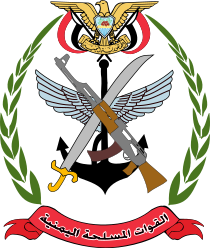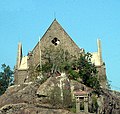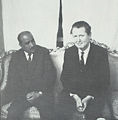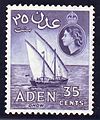Portal:Yemen
Yemen Portal


Owing to its geographic location, Yemen has been at the crossroads of many civilisations for over 7,000 years. In 1200 BCE, the
Since 2011, Yemen has been enduring
Selected article -
The
List of selected articles
|
|---|
|
Selected biography -
List of selected biographies
|
|---|
General images -
-
The critically endangered Arabian leopard (from Wildlife of Yemen)
-
Hawf, UNESCO World Heritage Site (from Tourism in Yemen)
-
Sana'a, was built in 1597 (from History of Yemen)
-
Saint Mary's Garrison church in Aden was built by the British in 1850 and is currently abandoned. (from History of Yemen)
-
The Qadi of Sa'dah, Yemen, in 1200-1210, according to the Maqamat al-Hariri (BNF 3929) (from History of Yemen)
-
Arabian boduis farm couple, possibly Yemeni (Códice Casanatense, c. 1540) (from History of Yemen)
-
Old City of Sana'a, UNESCO World Heritage Site (from Tourism in Yemen)
-
Old Walled City of Shibam, UNESCO World Heritage Site (from Tourism in Yemen)
-
Postage stamp of the Kathiri state of Sai'yun with portrait of Sultan Jafar bin Mansur. Kathiri is Kingdom of Hadhramaut Protected/Controlled British Empire. (from History of Yemen)
-
Rasulid Kingdom around 1264 AD (from History of Yemen)
-
Jabal Haraz, UNESCO Tentative Site (from Tourism in Yemen)
-
Sabaean gravestone of a woman holding a stylized sheaf of wheat, a symbol of fertility in ancient Yemen (from History of Yemen)
-
TheWāli (Governor) of Yemen Ahmed Muhtar Pasha (from History of Yemen)
-
Abdullah as-Sallal, North Yemen President and Dana Adams Schmidt. (from History of Yemen)
-
The Himyarite Kingdom at its height in 525 AD (from History of Yemen)
-
Bridge at Shaharah in the western highlands, with terracing at top right (from Wildlife of Yemen)
-
The Madrasa Amiriya of Rada, UNESCO Tentative Site (from Tourism in Yemen)
-
Queen Arwa al- Sulaihi Palace (from History of Yemen)
-
Slave-market in the town of Zabid in Yemen. Illustration from the 1237 Maqamat al-Hariri produced in Baghdad by al-Wasiti (Arabe 5847) (from History of Yemen)
-
Ruins of The Great Dam of Marib (from History of Yemen)
-
Protest in Sana'a, 3 February 2011 (from History of Yemen)
-
Jibla and its surroundings, UNESCO Tentative Site (from Tourism in Yemen)
-
Current (November 2021) political and military control in ongoing)Islamic State of Iraq and the LevantControlled by Southern Transitional Council(from History of Yemen
Selected city -

Selected picture -
-
dragon's blood tree (Dracaena cinnabari) in Socotra
-
Bronze lion with a rider made byQatabaniansthe circa 75-50 BCE.
-
A bronze statue of Dhamar Ali Yahbur II, a Himyarite Kingdom king who probably reigned in late 3rd or early 4th century AD. Displayed in the Sana'a National Museum.
-
Seiyun Palace was the royal residence of the sultan of Kathiri, located in the town of Seiyun in the Hadhramaut region, Yemen. It is one of the world’s largest mud-brick structures.
-
Temple of Awwam in Marib.
-
A Yemeni Jambiya
-
Barran Temple in Marib.
-
Al Saleh Mosque in Sana'a.
-
Jews of Maswar, Yemen, in 1902
-
A Griffon from the royal palace at Shabwa, the capital city of Hadhramaut
-
Ruins of the Great Marib Dam (1988)
Selected cuisines, dishes and foods -
List of articles
|
|---|
Related portals
Religions in Yemen
Arab states
Categories
Topics
Related portals
Religions in Yemen
Arab states
Associated Wikimedia
The following Wikimedia Foundation sister projects provide more on this subject:
-
Commons
Free media repository -
Wikibooks
Free textbooks and manuals -
Wikidata
Free knowledge base -
Wikinews
Free-content news -
Wikiquote
Collection of quotations -
Wikisource
Free-content library -
Wikiversity
Free learning tools -
Wiktionary
Dictionary and thesaurus








































































